St. Anne mine
Encounter with true darkness
The St. Anne mercury mine is located 9 kilometres north of Tržič near the hamlet of Lajb, along the road that leads towards Ljubelj (Loibl) along Mošenik Brook. The system of shafts is preserved in its entirety and is 5 kilometres long, and lies hidden beneath the surface of the southeastern slope of Begunjščica. Visitors can go on a guided tour along Anton's Shaft in the fifth horizon.
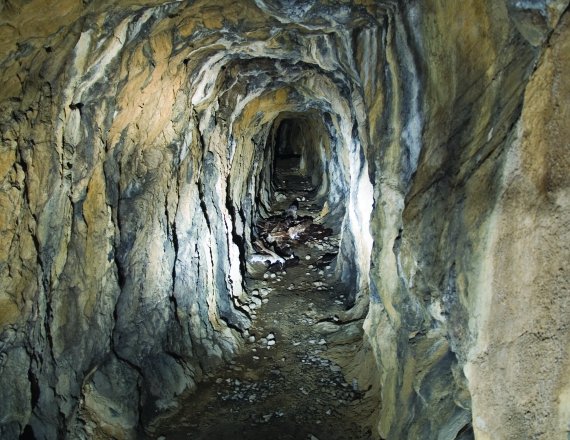 1 / 15 St. Anne mine
1 / 15 St. Anne mine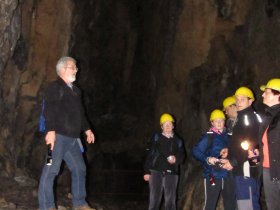 2 / 15 St. Anne mine
2 / 15 St. Anne mine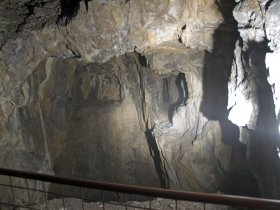 3 / 15 St. Anne mine
3 / 15 St. Anne mine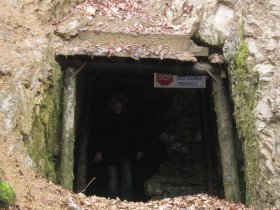 4 / 15 St. Anne mine
4 / 15 St. Anne mine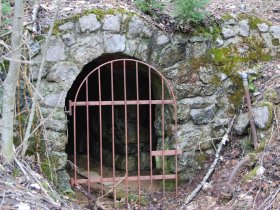 5 / 15 St. Anne mine
5 / 15 St. Anne mine
A hamlet from Roman times
Archeological finds provide evidence that there were people living here as far back as in the Roman period, since there was a shrine here to the Roman god Mercury, the patron of travellers. An important transportation route over Ljubelj (Loibl) to the northern side of the Karawanks passed through here along the Draga Valley and across Preval. In the Middle Ages the shrine was replaced by the Church of St. Anne, after which the entire valley and the mine were named.
The origins of mining in St. Anne Valley
Cinnabar, the ore from which mercury is extracted, was discovered in the vicinity of Podljubelj back in the mid-16th century. In 1670 deposits were found in Lajb that were rich enough to warrant extraction. Mercury, the only metal that remains in a liquid state at normal temperature and pressure, was obtained from the cinnabarite. It was used in particular in obtaining and cleaning gold and silver, in medicine, and in photography techniques, and especially in the armaments industry (ignition devices for explosives).
Intermittent operations
Experienced miners from Idrija came to Podljubelj and marked the site with the Idrija mining symbol; later on it became the property of the state. Reliable data for the first centuries of its operation are not available. Up until the last quarter of the 19th century the mine changed owners and leaseholders many times and operated intermittently. In 1875, a year after the founding of the Illyrian Mercury Association, it began regular production that lasted a quarter century. During that time a mining settlement grew up in Lajb and the so-called "Brothers' Fund" was established, a form of medical and pension insurance for the employees of the mine.
In 1891 the mine together with the surrounding land was purchased by the German banker Baron Julij Born, and after his death it passed to his son Friderik. For its time the mine was very modern; in 1893 it was, along with the Idrija mine, one of only two mines in Slovenia supplied with electricity. It employed about 40 miners, 25 collectors, among which the majority were women, and four workers in the furnace. It also had its own laboratory.
The end of mining activities
Mining ceased in 1902 due to the low content of mercury in the ore. Later, during the First World War, the great needs of the military for mercury led the military administration of Austria-Hungary to restart operations at the mine. However, the discovery of new materials reduced the need and so the mining activity at Lajb was not revived. Studies performed after the Second World War showed that its operation would not be economically justified.
Altogether about 110,000 tons of ore and at most 300 tons of mercury were obtained from the Podljubelj mine.
How can you recognize cinnabar in St. Anne Mine?
Ore deposits in Podljubelj formed at about the same time as those in Idrija, about 240 mllion years ago. The ore is of a hydrothermal vein type, which means that it was carried to the surface from deep within the earth's crust by hydrothermal water pushing through tectonic fissures in the rock.
There are two parallel ore-containing zones, the northern and southern, with a 20-metre-wide barren zone between them. The ore-bearing limestone extends east-west in a belt about 400 metres long and up to 100 metres wide along the southern slope of Begunjščica. Other mineral ores have not been found here.
Cinnabar usually appears in the form of tiny veins in the rock. Cinnabar grains can be found in white calcite veins in darker, fine-grained limestone, while in lighter, partially dolomitized limestone cinnabar fills a web of thin fissures. The ore appears in the form of flakes and films in tectonic nappes. Visitors upon seeing it often wonder whether it is really ore or whether someone simply drew a line with red chalk. Without a doubt it is real cinnabar.
Seven horizons - 5 kilometres of shafts
Miners dug in steep open pits in seven horizons. of which five were interconnected by means of a 150-metre-long blind shaft. The entire system of pits and shafts is five kilometres in length and is preserved in its entirety: along Potočnik Shaft remains of the shaft kilns can also be seen. The lowest shaft, called Julij, which was used to drain water, lies at an elevation of 700 m above sea level and is more than 2000 m long. A service line was run through August Shaft, and Friderik Shaft was the main exit shaft for tailings, while most of the ore was transported out through the higher-lying Jakob Shaft. Anton's Shaft was important for ventilation. The higher-lying Jurij Shaft (837 m above sea level) and Alojz Shaft (864) were not connected with the rest of the system.
Anton's Shaft is open to visitors.
Anton's Shaft on the fifth horizon with an entrance at 819 metres above sea level is open to visitors. Moonmilk appears on the walls of the shaft in vertical strips, particularly in visibly fractured areas. Moonmilk forms coatings of cauliflower-like form that are a dirty white in colour. The dark grey to black limestone is riddled with white calcite veins in which cinnabar appears in fine veins. There are two prominent, near-vertical fractured slabs in the shaft. The larger is 12 m high and the smaller is 8 m.
In the mine today there live cave beetles and bats, and here and there other insects drawn to the still, moist conditions in the caves take refuge there. To tour the mine, which can be arranged through the Tržič Tourism Promotion and Information Centre (TPIC Tržič), you will need a guide, helmet, flashlight, and appropriate footwear.
During the tour be aware that you are entering a fragile ecosystem. Take care not to damage the moonmilk-covered walls and ore-containing rocks, and be sure not to disturb the animals that make their home in the shaft.
"Šentanček" looks forward to your company
In the mine there lives a gnome called Šentanček. Ever since the miners left he has become a little lonely. You see, he used to help the miners. He showed them where mercury could be found, but in exchange he expected to be fed. If he wasn't given anything to eat, he would play a trick on the miners and hide their lunch. For many years now there have been no miners in this mine and sometimes he can only tease some bat or cave cricket. Don't get me wrong, cave gnomes are friendly. People call them "bergmandelci". The gnomes know very well that you would like to see them, but they don't show themselves to just anyone. If you want to see one you will need to be very resourceful. Good luck!
New free tourist shuttle, Saturdays and Sundays, 28.6 - 31.8.2024: departures from Tržič in front of the former Peko factory, the main bus station and the Tržič Primary School: 7.00, 9.30,13.00, 15.30 and 18.00 in the direction of Podljubelj campsite, during the Šentanski minnik guided tours. Visits to the Šentanski Mine are scheduled during the tourist bus tours, every Saturday and Sunday, at 16:00. The guide will meet you at the bus stop in front of the former Hotel Gora (Podljubelj 287A). Price: 5eur/person.
TOURIST BUS SCHEDULE IN-BETWEEN STATIONS
ContaCt and further information
TPIC Tržič, Trg svobode 18
T: 04 59 71 536 / 051 627 057
E: informacije@trzic.si
Opening hours
Tours must be arranged in advance in TPIC Tržič.
Entrance fee
- groups with more than 12 people: children, students, retired: 5,50 EUR/person, adults 7,50 EUR/person
- groups with less than 12 people: 70.00 EUR/group
- school groups and retired to 15 people: 60.00 EUR/group
